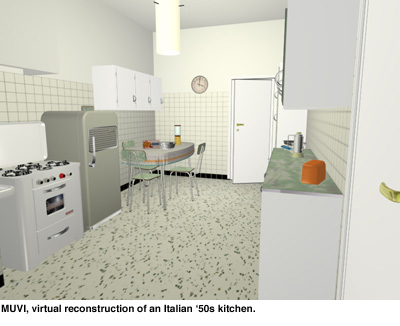
ERCIM News No.44 - January 2001 [contents]

![]()
ERCIM News No.44 - January 2001 [contents]
by Maria Chiara Liguori, Donatella Vasetti, Maria Elena Bonfigli, Antonella Guidazzoli and Alessio Mauri
Museums of Daily Life are dedicated to the reconstruction of domestic interiors and the displaying of consumer goods and other items related to everyday life in a certain period in time. The MUVI project, partially sponsored by ‘Bologna 2000’, realizes a VIrtual MUseum of Daily Life in 20th century Bologna and has been conceived as an interactive Virtual Environment (VE) accessible through the Web and the Virtual Theatre of CINECA, Supercomputing Centre in Bologna.
Daily Life Museums, common in Anglo-Saxon countries, are non-existent in Italy. The high costs involved in attempting to preserve Italy’s enormously rich cultural heritage mean that there are cost priorities which make the creation of new museums very difficult, in particular where this particular type is concerned.
However, the use of Virtual Reality and Interactive Computer Graphics can offer a satisfactory alternative solution by:
The MUVI project consists of the development of an innovative interface system (implemented using an XML-based markup language) for accessing a corpus of information related to reconstructed virtual environments. 3D models of domestic interiors and historical information are coded in order to allow the user to personalize the type of information he/she is given during a virtual tour in the Daily Life Museum.
Each user type accesses a tailored version of the VE built dynamically and interactively on the basis of his/her language, profile, particular interests, and level of competence and knowledge. There is no doubt that different users (tourists, students, researchers, etc.) have different interests and needs: for example a researcher needs a more detailed description than a simple visitor, who may have a stronger interest in anecdotes than in historical analysis.
The interface enables the user to choose which elements are to be visualized during the virtual visit. In this way, the user will be able to visualize only those virtual components in which he/she is interested eg architectural elements, objects and their contextualization, photos, magazine and TV adverts, TV films, recorded speeches, etc. Moreover, in order to provide the visitor with "interesting" background information, every 3D object is linked to a historical description of the resources on which the virtual reconstruction is based. In this case too, the user can personalize the type of information to be received, obtaining for example just the visualization of the virtual environment, or simple descriptions of the 3D objects or more details about the related resources or the historical hypothesis.

After studying two sample cases, a kitchen and living-room of the 1950s, the overall project plan was structured as follows:
The instruments used in this multidisciplinary project, involving computer scientists, historians and 3D modelers, include:
MUVI implements a new way to access a ‘certified’ corpus of 3D models and related historical information - that can be expanded over time – creating a Virtual Museum which can be personalised according to user profiles. The project for the first two rooms, the Italian kitchen and living-room of the Fifties, will end around June 2001.
Links:
The MUVI project: http://www.cineca.it/muvi/
CINECA’s Virtual Theatre: http://www.cineca.it/visit/virtualtheatre.html
Please Contact:
Maria Chiara Liguori, Donatella Vasetti - University of Bologna
Tel: +39 051 6171920
E-mail: mliguori@cineca.it, vasetti@mail.cib.unibo.it
Maria Elena Bonfigli, Antonella Guidazzoli, Alessio Mauri - CINECA SuperComputing Centre
Tel: +39 051 6171920
E-mail: {e.bonfigli | a.guidazzoli | a.mauri}@cineca.it